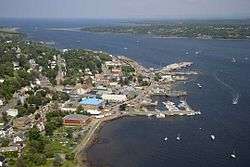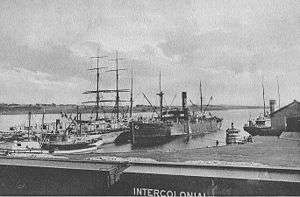Pictou Harbour
Pictou Harbour is a natural harbour in Nova Scotia on the Northumberland Strait.[1]

Geography
The distance between the town of Pictou on the north shore, and the community of Pictou Landing to the south is about 1 km (0.62 mi). The south side of the harbour opens into the broad mouth of the East River of Pictou which flows inland through the towns of Trenton and New Glasgow. The south-west end of the harbour is bisected by the Harvey Veniot causeway that carries Nova Scotia Highway 106. The causeway has limited the navigable portion of the harbour to approximately 5 km (3.1 mi) in length. Prior to the opening of the causeway in 1968,[2] the harbour continued into the confluence of the West River of Pictou and Middle River of Pictou, both of which were navigable.
The body of water immediately outside the harbour is known as the Pictou Road.[3][4] The entrance to the harbour is protected by two sandbars and is about 400m wide. A lighthouse was installed on this bar in 1834 and lost to fire in 1903. Its replacement, a 55-foot octagonal tower was also destroyed by fire on July 5, 2004.[5]
History
The first settlers arrived in Pictou Harbour in 1767 on the Betsey from Philadelphia. The Hector arrived in 1773, bringing the first Scottish settlers to arrive in the province directly from Scotland. Timber was being exported to Britain from Pictou harbour as early as 1777 and the first ship was built there in 1788 by Thomas Copeland. By 1803, fifty vessels loaded squared timber for Britain.[6] The Harriet was launched in 1798 with a registered tonnage of 422 tons and is believed to be the largest built in Nova Scotia at the time.[7]
By 1830 coal was being brought from the inland towns by steamboat for transshipment and soon coal and iron were the chief exports through the harbour.[6] The Pictou coalfield may not have developed prior to the building of the mainline railways in the 1860s and 1870s if it weren't for its proximity to Pictou harbour, and coal shipments continued until shortly after World War II.[8] Pictou thrived as a port, and the United States government recognized its importance and operated a consulate from 1837 to 1897 to look after its interests in Pictou County coal and fish from the Gulf of St. Lawrence.[9] Pictou opened as a port of registry in 1840 and at that time was registering between 20 and 40 ships a year.[10] In 1874 the Customs House was built by the Dominion Government to collect tariffs and duties, and control goods and people flowing through the port, which was a significant port of entry at the time, and the main passenger connection with Upper Canada.[6]

The first railway to reach Pictou Harbour was in 1867 when the Pictou extension of the Nova Scotia Railway reached Pictou Landing on the south shore of the harbour.[11] From there the railway company operated a steam-powered ferry to take passengers across the harbour where they could connect with ships leaving for Prince Edward Island and Montreal.[6] There was also a coal pier there for loading ships.[12] The Intercolonial Railway opened a line into Pictou town in 1887,[13] crossing the harbour at the mouth of the West River. The bridge, known as Mile Bridge, was destroyed by fire in 1993.[14] Ferry service from the upriver towns declined with the introduction of rail service and ceased in the 1920s due to the increasing use of cars, but the ferry between Pictou, Pictou Landing and Abercrombie continued until after World War 2.[15]
On August 24, 1873 a hurricane caused extensive damage throughout the harbour. The water rose above the wharves, causing goods and lumber to be washed away. Wharves and coal piers on both sides of the harbour were extensively damaged and ships at anchor were driven ashore. The brigantine Willow Brae was driven up the Middle River and 300 tons of coal had to be unloaded before she could be salvaged. The schooner Guiding Star carrying 140 tons of coal went so far up the Middle River that she had to be abandoned.[16]
The Canadian Trade Review reported in 1900 that Pictou harbour was also handling produce and dairy products from Prince Edward Island, as well as most of the lobster from the eastern end of the Gulf. It was also importing iron ore from the mine at Belle Isle, Newfoundland, for the Nova Scotia Iron Company smelters at Ferrona, and copper ore for the Copper Crown Company in Pictou.[17] A pier at Granton on the Middle River, 3 miles upstream from the harbour, was loading steamships of 3,000 ton capacity with coal from the Drummond colliery in Westville.[18]
On September 25, 1925 the cargo steamer Dieuze caught fire and sank outside the shipping lane. The captain was the only person aboard at the time and he survived. The wreck was rediscovered in 2015 during surveying work by the Canadian Hydrographic Service sitting upright on the bottom in 13.5 metre deep water, but it wasn't until divers explored the wreck that it could be identified.[19][20][21]
Pictou Shipyard was established during World War 2, causing the population of the town to triple,[22] and is notable for its construction of 24 Park ships over a two-year period during World War 2,[23] and continues in business today.
The landscape of the harbour changed considerably in the late 1960s with the construction of a kraft pulp mill at Abercrombie Point, between the East and Middle rivers. At the same time the Middle river was dammed to supply fresh water to the mill, and a causeway was constructed to carry Highway 106 across the harbour from Abercrombie Point to Pictou.[24]
Current usage of the harbour
In Pictou town, the Pictou Marine Terminals offer three berths for ships up to 150m,[25] and a 17 berth marina for small pleasure craft and a Canadian Coast Guard Inshore Search and Rescue Service boat.[26] The Hector Heritage Quay Visitor's Marina has moorings for 40 pleasure craft.[27] On the outskirts of town is the private Pictou Marina, home of the Pictou Yacht Club.[27] Directly across the harbour from there is a fishing wharf at Pictou Landing. Cruise ships began visiting Pictou in 2014.[28]
Environment
Being an estuary, the water is considered brackish, with a density of about 1019 kg/m3 that varies seasonally.[25] The sand bar on the southside of the harbour entrance is an 8ha Provincial Nature Reserve, comprising beaches and dunes that provide habitat for the endangered piping plover.[29] Human settlement and industrial activity have impacted Pictou harbour since the 18th century through pollution, impacts on wilderness habitat and harvesting of renewable resources.[3] It is still a highly productive fish habitat which supports a variety of fish species, including oysters, clams, mackerel, herring, Atlantic salmon, striped bass, and brown trout.[30]
References
- "Pictou Harbour". Geographical Names Board of Canada. Natural Resources Canada. Retrieved 11 July 2017.
- "Harvey A. Veniot causeway construction". Nova Story Digital Collections. Pictou-Antigonish Regional Library. Retrieved 12 July 2017.
- Cuttell, Patricia May (March 1988). "Increasing community capacity in coastal zone management" (PDF). Collections Canada. Library and Archives Canada. pp. 24–28. Retrieved 7 August 2017.
- "Pictou Road". Geographical Names Board of Canada. Natural Resources Canada. Retrieved 8 August 2017.
- "Pictou Lighthouse in the Distance". Nova Story Digital Collections. Pictou-Antigonish Regional Library. Retrieved 7 August 2017.
- Graham, Monica (2004). The Historic Town of Pictou. Halifax, Nova Scotia: Nimbus Publishing. ISBN 1-55109-501-7.
- Armour, Charles A; Lackey, Thomas (1975). Sailing Ships of the Maritimes. McGraw-Hill Ryerson Limited. p. 16. ISBN 9780070777569.
- Cameron (1974), p. 267.
- Cameron, James Malcolm (1994). "The Consulate at Pictou". Yesteryears in Pictou County. Pictou County Historical Society. pp. 24–28. Retrieved 19 August 2017.
- Armour, Charles A; Lackey, Thomas (1975). Sailing Ships of the Maritimes. McGraw-Hill Ryerson Limited. p. 162. ISBN 9780070777569.
- "The "Pictou Extension" Railway". Nova Scotia's Electric Gleaner. Ivan Smith. Retrieved 9 August 2017.
- "Historic". The Harbour Authority Of Pictou Landing. Retrieved 14 August 2017.
- "Inter Colonial Railway". Nova Story Digital Collections. Pictou-Antigonish Regional Library. Retrieved 8 August 2017.
- "Mile Bridge Fire :: Pictou Historical Photograph Society". Nova Story Digital Collections. Pictou-Antigonish Regional Library. Retrieved 20 October 2017.
- Cameron, James Malcolm (1994). "The Trenton Shipyard". Yesteryears in Pictou County. Pictou County Historical Society. p. 71. Retrieved 19 August 2017.
- Cameron, James Malcolm (1994). "The August Gale". Yesteryears in Pictou County. Pictou County Historical Society. pp. 75–79. Retrieved 19 August 2017.
- "Pictou County, Nova Scotia". The Canadian Trade Review Finance and Insurance record devoted to the Manufacturing Interests of the Dominion. Henry Harvey & Co. XXIX (24): 55. Oct 12, 1900. Retrieved 20 August 2017.
- "Pictou County, Nova Scotia". The Canadian Trade Review Finance and Insurance record devoted to the Manufacturing Interests of the Dominion. Henry Harvey & Co. XXIX (24): 60. Oct 12, 1900. Retrieved 20 August 2017.
- Graham, Monica (July 25, 2015). "Shipwreck site in Pictou Harbour 'amazing': diver". The Chronicle Herald. Retrieved 12 July 2017.
- Pate, David (Jul 25, 2015). "Pictou Harbour underwater expedition uncovers mystery wreck". CBC News. Retrieved 12 July 2017.
- Pate, David (Aug 1, 2015). "Pictou Harbour mystery wreck remembered". CBC News. Retrieved 12 July 2017.
- Bruce, Marian (2014). Saltwater Road. Wood islands and Area Development Corporation. p. 46. ISBN 9780973755657.
- "Park Ship S. S. Ashby Park 1944". Nova Story Digital Collections. Pictou-Antigonish Regional Library. Retrieved 8 August 2017.
- Baxter, Joan (2017). The Mill. Pottersfield Press. p. 40. ISBN 9781988286174.
- "Port particulars". Pictou Marine Terminals. Retrieved 14 August 2017.
- "PMT marina". Pictou Marine Terminals. Retrieved 14 August 2017.
- "Port of Pictou". Town of Pictou. Retrieved 14 August 2017.
- "10 cruise ship visits planned for 2015". The News. Transcontinental Media. January 5, 2015. Retrieved 19 August 2017.
- "Lighthouse Beach Nature Reserve". Province of Nova Scotia. Retrieved 7 August 2017.
- "R. v. Northern Pulp Nova Scotia Corporation, 2016 NSPC 29 (CanLII)". CanLII. Federation of Law Societies of Canada. Retrieved 16 October 2017.
- Cameron, James M. (1974). The Pictonian Colliers. Halifax, Nova Scotia: Nova Scotia Museum. Retrieved 10 October 2017.
External links
- 7 day tidal prediction chart for Pictou
- Quarterly Return of Articles Imported within the District of Pictou between the 31st day of December, 1865 and the 31st March, 1866, subject to Provincial Duties for the support of Her Majesty's Government, Nova Scotia.
- Photograph of vessels in Pictou Harbour, 1900